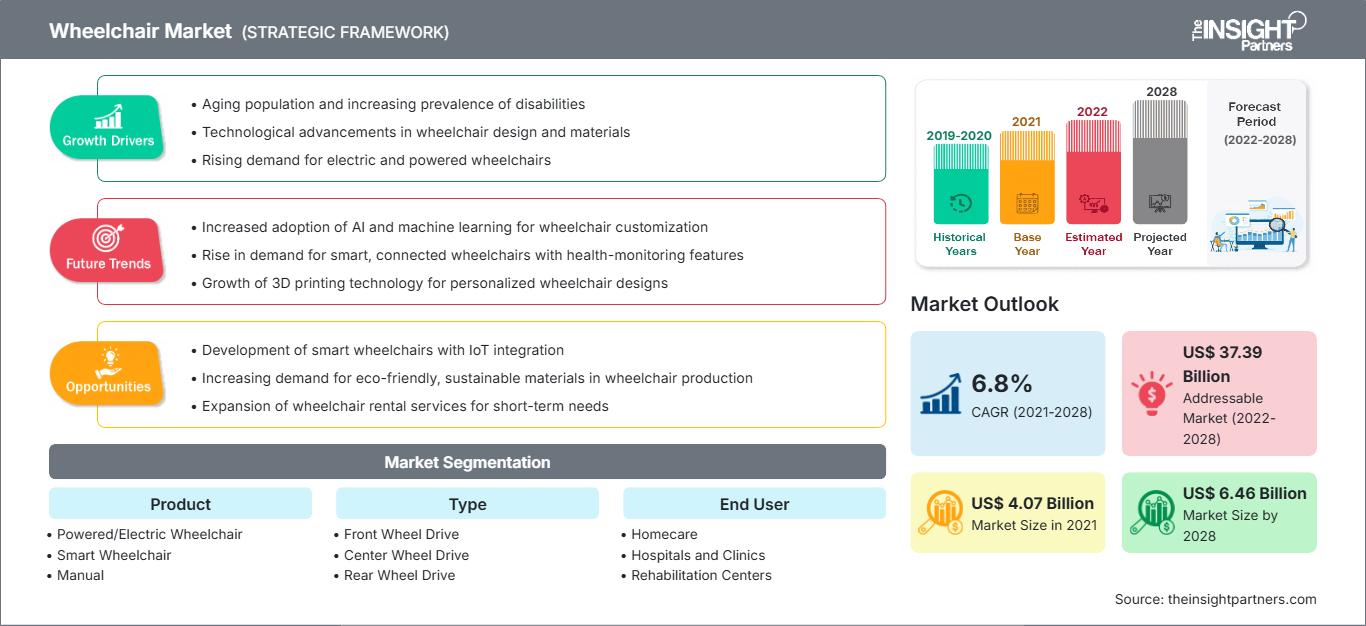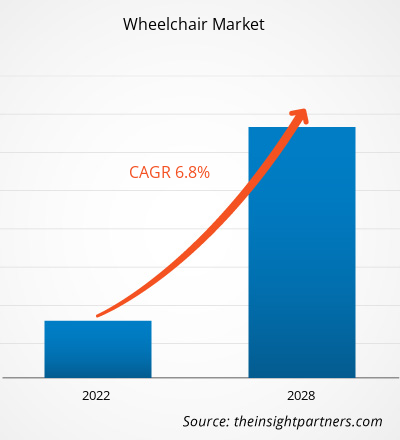Der Markt für Rollstühle wurde im Jahr 2021 auf 4.073,71 Millionen US-Dollar geschätzt und soll bis 2028 6.459,07 Millionen US-Dollar erreichen; von 2021 bis 2028 wird ein durchschnittliches jährliches Wachstum von 6,8 % erwartet.
Patienten nutzen Rollstühle, wenn sie aufgrund einer Verletzung, Krankheit oder Behinderung nicht gehen können. Je nach Bedarf des Patienten sind verschiedene Arten von Rollstühlen auf dem Markt erhältlich. Es gibt eine große Auswahl an Rollstühlen, die sich in Steuerungsmechanismen, Antriebsmethoden und der verwendeten Technologie unterscheiden. In den letzten zehn Jahren wurden erhebliche Anstrengungen unternommen, um Rollstühle mit innovativen Funktionen zu entwickeln.
Der Umfang des Rollstuhlmarktes umfasst Produkt, Typ, Endbenutzer, Anwendungen, Nutzung, Vertriebskanal und Region. Der Markt für Rollstühle wird anhand von Regionen wie Nordamerika, Europa, Asien-Pazifik, Naher Osten und Afrika sowie Süd- und Mittelamerika analysiert. Der Bericht bietet Einblicke und eine eingehende Analyse des Rollstuhlmarktes und legt dabei den Schwerpunkt auf verschiedene Parameter wie Markttrends, technologische Fortschritte, Marktdynamik und eine Analyse der Wettbewerbslandschaft führender Marktteilnehmer weltweit.
Sie erhalten kostenlos Anpassungen an jedem Bericht, einschließlich Teilen dieses Berichts oder einer Analyse auf Länderebene, eines Excel-Datenpakets sowie tolle Angebote und Rabatte für Start-ups und Universitäten.
Rollstuhlmarkt: Strategische Einblicke

-
Holen Sie sich die wichtigsten Markttrends aus diesem Bericht.Dieses KOSTENLOSE Beispiel umfasst Datenanalysen, die von Markttrends bis hin zu Schätzungen und Prognosen reichen.
Das höhere Risiko körperlicher Behinderungen bei älteren Menschen steigert die Nachfrage nach Rollstühlen. Laut den Vereinten Nationen haben weltweit 46 % der Menschen ab 60 Jahren eine Behinderung; ca. 250 Millionen Menschen haben mittelschwere bis schwere Behinderungen. Darüber hinaus trägt die Anhäufung von Gesundheitsrisiken im Laufe des Lebens durch Krankheiten, Verletzungen und chronische Erkrankungen zu höheren Behinderungsraten bei älteren Menschen bei. Laut dem World Population Ageing Report der Vereinten Nationen ist die globale Bevölkerung der 60-Jährigen und Älteren im Jahr 2017 auf 962 Millionen angestiegen (1980 waren es ca. 382 Millionen), also mehr als das Doppelte. Der Bericht erwähnt auch, dass sich die Zahl älterer Menschen bis 2050 voraussichtlich weiter verdoppeln und ca. 2,1 Milliarden erreichen wird. Laut dem US Census Bureau gab es im Juli 2019 54 Millionen Einwohner der USA im Alter von 65 Jahren und älter. Darüber hinaus schätzte das Urban Institute, dass die Zahl der US-Bevölkerung in dieser Altersgruppe bis 2040 80 Millionen erreichen wird. Entsprechend waren in Indien laut der Volkszählung von 2011 etwa 104 Millionen Inder 60 Jahre oder älter, darunter etwa 53 Millionen Frauen und 51 Millionen Männer. Laut einem Bericht des Bevölkerungsfonds der Vereinten Nationen und von HelpAge wird die ältere Bevölkerung in Indien bis 2026 voraussichtlich auf 173 Millionen anwachsen.
Daher steigert die wachsende alternde Bevölkerung weltweit die Nachfrage nach Rollstühlen.
Produktbasierte Erkenntnisse zu Rollstühlen
Basierend auf dem Produkt ist der Rollstuhlmarkt in Elektrorollstühle, intelligente Rollstühle und manuelle Rollstühle segmentiert. Das Segment der manuellen Rollstühle hatte 2021 den größten Marktanteil, während für das Segment der motorisierten/elektrischen Rollstühle im Prognosezeitraum die höchste durchschnittliche jährliche Wachstumsrate (CAGR) erwartet wird.
Einblicke nach Rollstuhltypen
Nach Typ ist der Rollstuhlmarkt in Rollstühle mit Frontantrieb, Mittelradantrieb, Hinterradantrieb und elektrische Stehrollstühle unterteilt. Das Segment mit Mittelradantrieb hatte 2021 den größten Marktanteil und wird im Prognosezeitraum voraussichtlich die höchste durchschnittliche jährliche Wachstumsrate (CAGR) verzeichnen. Das Wachstum dieses Segments ist auf die Vorteile des Mittelradantriebs zurückzuführen, wie z. B. die einfache Navigation durch Türen und enge Räume sowie die überlegene Stabilität.
Einblicke nach Endnutzern von Rollstühlen
Nach Endnutzern ist der Rollstuhlmarkt in häusliche Pflege, Krankenhäuser und Kliniken, Rehabilitationszentren und ambulante chirurgische Zentren unterteilt. Das Segment der Rehabilitationszentren hatte 2021 den größten Marktanteil und wird im Prognosezeitraum voraussichtlich die höchste durchschnittliche jährliche Wachstumsrate (CAGR) verzeichnen. Das Wachstum dieses Segments wird auf die steigende Zahl von Rehabilitationszentren in Verbindung mit einer steigenden Zahl von Erkrankungen des Bewegungsapparats zurückgeführt.
Anwendungsbasierte Erkenntnisse
Basierend auf der Anwendung ist der Rollstuhlmarkt in Patienten mit neurologischen Beeinträchtigungen, Patienten mit Behinderungen und Sonstige segmentiert. Das Segment der neurologischen Beeinträchtigungen hatte 2021 den größten Marktanteil und wird im Prognosezeitraum voraussichtlich die höchste CAGR auf dem Markt verzeichnen.
Nutzungsbasierte Erkenntnisse
Basierend auf der Nutzung ist der Rollstuhlmarkt in Erwachsene und Kinder (unter 18) segmentiert. Das Segment der Erwachsenen hatte 2021 einen größeren Marktanteil und wird im Prognosezeitraum voraussichtlich die höchste CAGR auf dem Markt verzeichnen.
Vertriebskanalbasierte Erkenntnisse
Basierend auf dem Vertriebskanal ist der Rollstuhlmarkt in Einzelhandel und E-Commerce segmentiert. Der Einzelhandel hatte 2021 den größten Marktanteil. Allerdings wird das E-Commerce-Segment im Prognosezeitraum voraussichtlich die höchste durchschnittliche jährliche Wachstumsrate (CAGR) auf dem Markt verzeichnen.
Die COVID-19-Pandemie ist weltweit zur größten Herausforderung geworden. Diese Herausforderung wird insbesondere in Entwicklungsländern weltweit beängstigend sein, da sie aufgrund von Störungen im Welthandel zu einem Rückgang der Importe führen wird. Die COVID-19-Pandemie wirkte sich weltweit auf die Pharma- und Medizinproduktebranche, die Forschung und Entwicklung sowie weitere Unternehmen aus. Rollstühle sind in verschiedenen Mobilitätssituationen unverzichtbare medizinische Geräte. Da der Beginn der Pandemiekrise ungewiss war, herrscht ein Mangel an Rollstühlen und Verbrauchsmaterialien. Die Marktteilnehmer verfolgen jedoch verschiedene Strategien, um die Verbreitung von Rollstühlen zu steigern. Nach Angaben des Britischen Roten Kreuzes beispielsweise versorgte die Organisation im Jahr 2020 rund 140 Gemeinden in ganz Großbritannien mit Rollstühlen. Außerdem stellte die Organisation rund 50.000 Rollstühle für Patienten mit dauerhaften und vorübergehenden Mobilitätseinschränkungen bereit.
Unternehmen nutzen häufig Produkteinführungen und Expansionsstrategien, um ihre Präsenz weltweit auszubauen und die wachsende Nachfrage zu befriedigen. Marktteilnehmer nutzen diese Strategien häufig, um ihr Produktportfolio zu erweitern.
Die Marktteilnehmer im Rollstuhlmarkt verfolgen die Strategie der Produktinnovation, um der sich weltweit ändernden Kundennachfrage gerecht zu werden und so ihren Markennamen weltweit zu behaupten.
Rollstuhlmarkt
Die Analysten von The Insight Partners haben die regionalen Trends und Faktoren, die den Rollstuhlmarkt im Prognosezeitraum beeinflussen, ausführlich erläutert. In diesem Abschnitt werden auch die Marktsegmente und die geografische Lage in Nordamerika, Europa, dem asiatisch-pazifischen Raum, dem Nahen Osten und Afrika sowie Süd- und Mittelamerika erörtert.Umfang des Rollstuhlmarktberichts
| Berichtsattribut | Einzelheiten |
|---|---|
| Marktgröße in 2021 | US$ 4.07 Billion |
| Marktgröße nach 2028 | US$ 6.46 Billion |
| Globale CAGR (2021 - 2028) | 6.8% |
| Historische Daten | 2019-2020 |
| Prognosezeitraum | 2022-2028 |
| Abgedeckte Segmente |
By Produkt
|
| Abgedeckte Regionen und Länder |
Nordamerika
|
| Marktführer und wichtige Unternehmensprofile |
|
Dichte der Akteure auf dem Rollstuhlmarkt: Ihre Auswirkungen auf die Geschäftsdynamik verstehen
Der Rollstuhlmarkt wächst rasant, angetrieben durch die steigende Endverbrauchernachfrage aufgrund von Faktoren wie sich entwickelnden Verbraucherpräferenzen, technologischem Fortschritt und einem stärkeren Bewusstsein für die Produktvorteile. Mit steigender Nachfrage erweitern Unternehmen ihr Angebot, entwickeln Innovationen, um den Verbraucherbedürfnissen gerecht zu werden, und nutzen neue Trends, was das Marktwachstum weiter ankurbelt.

- Holen Sie sich die Rollstuhlmarkt Übersicht der wichtigsten Akteure
- Manueller Rollstuhl
- Elektrorollstuhl
- Standard-Elektrorollstühle
- Sonderangefertigte Elektrorollstühle
- Smart-Rollstuhl
Nach Typ
- Mittelradantrieb
- Frontantrieb
- Hinterradantrieb
- Elektrischer Stehrollstuhl
Nach Endbenutzer
- Rehabilitationszentren
- Krankenhäuser und Kliniken
- Häusliche Pflege
- Ambulante Operationszentren
Nach Anwendung
- Neurologisch beeinträchtigte Patienten
- Behinderte Patienten
- Sonstige
Nach Verwendung
- Erwachsene
- Kinder (unter 18)
Nach Vertriebskanal
- Einzelhandel
- E-Commerce
Nach Geografie
-
Nordamerika
- USA
- Kanada
- Mexiko
-
Europa
- Frankreich
- Deutschland
- Italien
- Großbritannien
- Spanien
- Restliches Europa
-
Asien-Pazifik (APAC)
- China
- Indien
- Südkorea
- Japan
- Australien
- Restliches Asien Pazifik
-
Naher Osten und Afrika (MEA)
- Südafrika
- Saudi-Arabien
- VAE
- Rest des Nahen Ostens und Afrika
-
Südamerika (SAM)
- Brasilien
- Argentinien
- Rest Südamerika
Firmenprofile
- Invacare Corporation
- Medline Industries, Inc.
- OTTOBOCK
- MEYRA GMBH
- KARMAN HEALTHCARE, INC
- Sunrise Medical
- HOVEROUND CORPORATION
- LEVO AG
- Permobil
- Smile Smart Technology
- Historische Analyse (2 Jahre), Basisjahr, Prognose (7 Jahre) mit CAGR
- PEST- und SWOT-Analyse
- Marktgröße Wert/Volumen – Global, Regional, Land
- Branchen- und Wettbewerbslandschaft
- Excel-Datensatz
Aktuelle Berichte
Verwandte Berichte
Erfahrungsberichte
Grund zum Kauf
- Fundierte Entscheidungsfindung
- Marktdynamik verstehen
- Wettbewerbsanalyse
- Kundeneinblicke
- Marktprognosen
- Risikominimierung
- Strategische Planung
- Investitionsbegründung
- Identifizierung neuer Märkte
- Verbesserung von Marketingstrategien
- Steigerung der Betriebseffizienz
- Anpassung an regulatorische Trends






















 Kostenlose Probe anfordern für - Rollstuhlmarkt
Kostenlose Probe anfordern für - Rollstuhlmarkt